
by Sarah Kuta
Last updated: 7:00 PM ET, Fri January 3, 2025
Perched on the edge of a rugged inflatable boat, I slip on my flippers and my snorkeling mask, then jump feet-first into the cerulean waters below. Swimming alongside fellow travelers from the MS Santa Cruz II, I follow our naturalist guide, Henry, as he leads us along the rocky shore of Santa Fe Island��s Barrington Bay.
Without warning, a huge school of sardines appears near the seafloor. And, soon, our wetsuit-clad group finds itself (safely) in the middle of a feeding frenzy.?
Blue-footed boobies torpedo into the water, skillfully nabbing the small, silvery fish on their way back to the surface. Sleek sea lions��who��d been lounging languidly in the sun just a few minutes earlier��dart through the water with ease, causing the mass of fish to expand, contract and part in mesmerizing unison. I spot a trio of blacktip reef sharks prowling patiently below, waiting for the right moment to grab a tasty morsel.
It��s easily one of the most incredible experiences of my life. But, on an HX expedition cruise in the Gal��pagos Islands, it��s just a standard, everyday occurrence. Animals are so abundant here��and so unperturbed by the presence of humans��that HX guests regularly get a front-row seat to the action, no binoculars or fancy cameras required.?
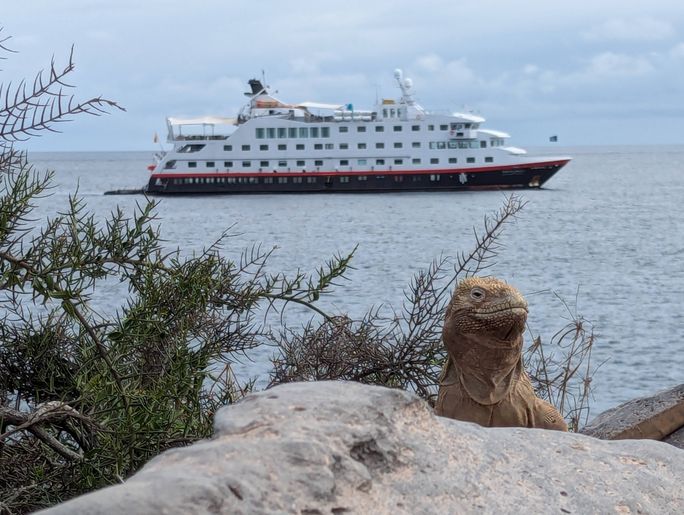
A land iguana poses in front of the MS Santa Cruz II on Santa Fe Island during an HX expedition cruise in the Gal��pagos Islands (Photo Credit: Sarah Kuta)
And my Santa Fe Island snorkeling adventure was just one of the many awe-inspiring wildlife encounters I had during my trip to the Gal��pagos, the chain of volcanic islands that famously inspired British naturalist Charles Darwin��s theory of evolution.
I saw nearly all of the ��Big 15����the Gal��pagos Islands�� version of the ��Big 5�� animals travelers try to spot while on safari in Africa. But, overall, the archipelago is home to more than 9,000 species of plants and animals, many of which are uniquely adapted to the environment. (My favorites were the adorably awkward waved albatrosses and the slow-and-steady giant tortoises.)
If you��re a wildlife and nature enthusiast like me, a Gal��pagos Islands expedition cruise is the perfect vacation. Here��s what it��s like to explore this iconic destination.
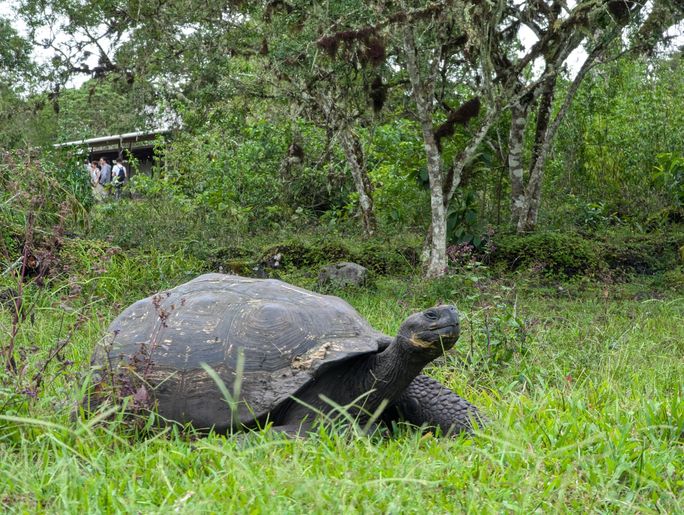
A giant tortoise wanders through the grass on Santa Cruz Island (Photo Credit: Sarah Kuta)
Adventuring in the Gal��pagos With HX
The Gal��pagos Islands are located in the vast Pacific Ocean roughly 600 miles off the coast of Ecuador. The archipelago consists of 127 islands, islets and rocks, including just four islands that are inhabited by humans.
Since 1959, 97 percent of the archipelago has been protected as?Gal��pagos National Park. The waters surrounding the islands are also protected under the?Gal��pagos Marine Reserve, which was created in 1986 and expanded in 1998. The archipelago has been a UNESCO World Heritage Site since 1978.
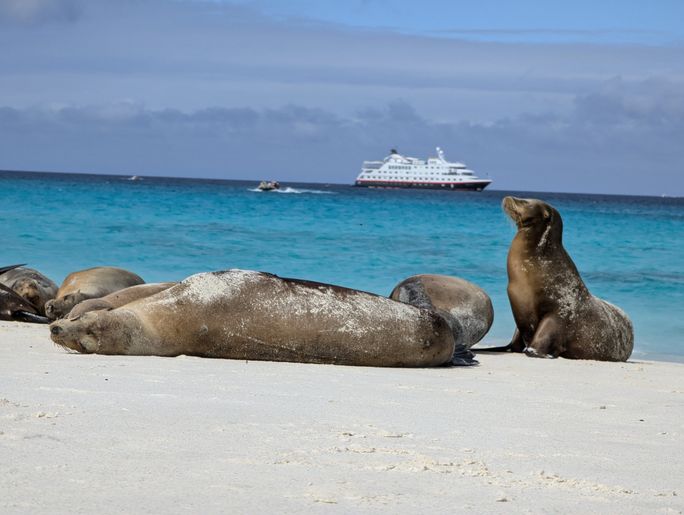
Sea lions lounge on the beach on Espa?ola Island (Photo Credit: Sarah Kuta)
HX��s 9-day ��In Darwin��s Footsteps (Eastern Route)�� itinerary starts in Quito, the 9,350-foot-high capital of Ecuador and a UNESCO World Heritage Site.
The itinerary's name is a nod to Charles Darwin, the British naturalist who visited the islands in September 1835 aboard the HMS Beagle during its five-year, around-the-world expedition. Darwin spent just five weeks in the?Gal��pagos, but his short visit helped give rise to his theory of evolution��the idea that plants and animals slowly adapt over time to give their species the best chance of survival.
After arriving in Quito, guests spend two nights at a hotel��on my trip, it was the JW Marriott Quito��and have the opportunity to participate in a full-day ��Historic Quito & Middle of the World�� tour before their cruise.
Led by guides with Metropolitan Touring, HX��s in-country partner, the excursion includes visits to San Francisco Catholic Church and San Francisco Convent in Quito��s Old Town; a chocolate-making workshop at Chez Tiff; lunch at El Cr��ter Restaurante; and free time at Middle of the World City, which straddles the equator.
Bright and early the next morning, travelers head together to the Quito airport for a flight to Baltra Island. After a short transfer to a small port��where blue-footed boobies, sea lions and Sally lightfoot crabs await��guests take their first ��panga�� boat (or Zodiac) ride to the MS Santa Cruz II.?
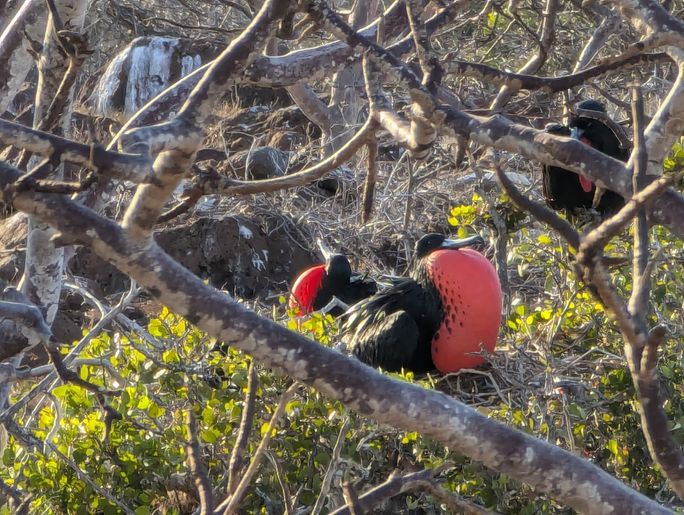
A male frigatebird shows off his inflated red neck pouch to females soaring overhead on North Seymour Island (Photo Credit: Sarah Kuta)
Once onboard, the whirlwind Gal��pagos expedition begins. The cruise visits multiple islands and islets on the eastern side of the archipelago��including, in some instances, several destinations in the same day.?
Stops on this itinerary include Mosquera Islet; Punta Pitt and Puerto Baquierizo Moreno on San Crist��bal Island; Santa F�� and South Plaza islands; Puerto Ayora on Santa Cruz Island; Espa?ola Island; Eden Islet; and North Seymour Island. (HX offers an array of? Gal��pagos itineraries, with visits to different destinations.)
For travelers who want to extend their time in South America, HX also offers several pre- and post-cruise packages. For example, guests who want to linger a little longer in the Gal��pagos can enjoy three nights at Finch Bay Gal��pagos Hotel, a high-end eco-lodge on the beach in Puerto Ayora. Or, for an adventurous experience on mainland Ecuador, travelers can spend three nights at Mashpi Lodge, located in the lush Choc�� rainforest.
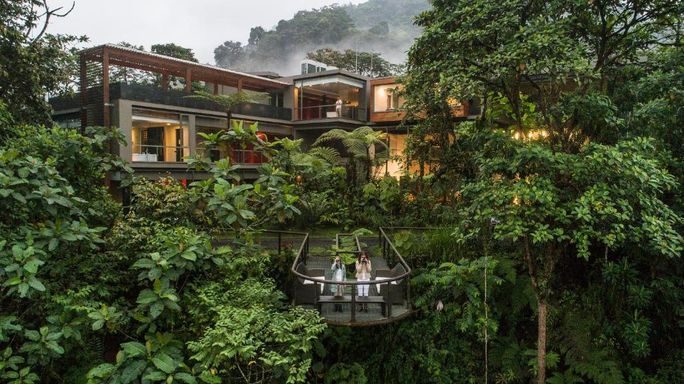
Travelers can extend their time in South America with a post-cruise package at Mashpi Lodge (Photo Credit: HX)
As of fall 2024, HX��s voyages?are all-inclusive. This means cruise fares now include all daily expeditions and activities; all dining; beer, wine, spirits and cocktails; coffee, tea and soft drinks; Wi-Fi; gratuities; access to the onboard Science Center and science activities; access to the fitness room and hot tubs; professional photos and videos taken by an onboard photographer; and a reusable water bottle. On Gal��pagos cruises, life jackets, wetsuits and snorkeling gear are also available on board at no extra cost.
Life Onboard the MS Santa Cruz II
Built in 2002 and refurbished in 2021, the 90-guest MS Santa Cruz II is a bright and comfortable home base for exploring the Gal��pagos.
The contemporary interior design features soothing blues, neutral grays, warm tans and light wood tones. Large, plentiful windows fill the ship with natural light and frame the views of the picturesque scenery outside. With its carbon-neutral operations, the vessel embodies HX��s sustainability ethos.
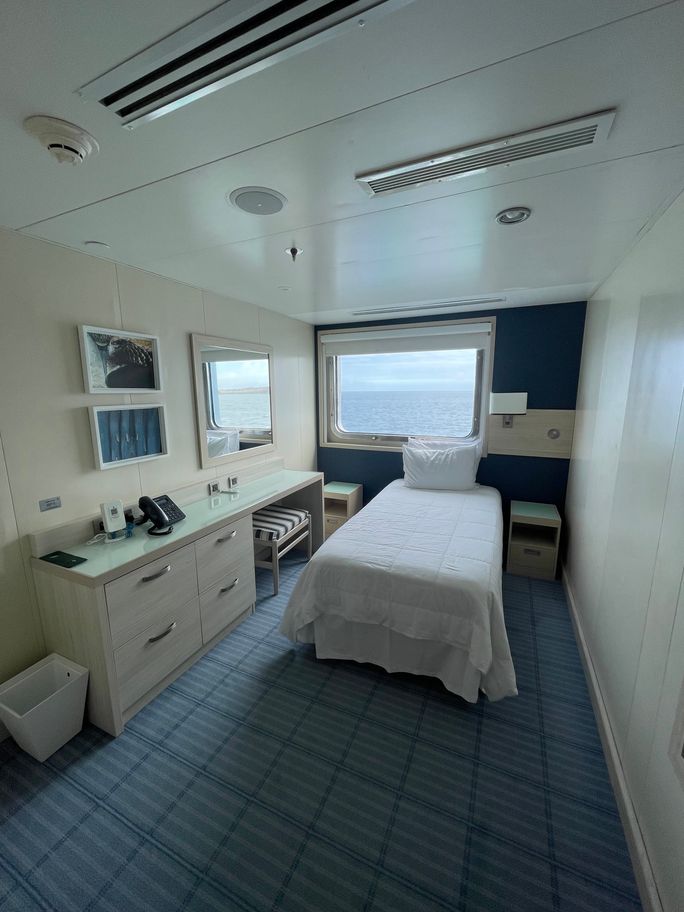
An Explorer Cabin for a solo traveler aboard the MS Santa Cruz II (Photo Credit: Sarah Kuta)
The MS Santa Cruz II offers multiple types of cabins and suites that can accommodate solo travelers, families, couples and groups. The most abundant are the ��Explorer Cabins,�� which come in several different configurations. The standard setup has a double bed (for up to two guests), while others feature a single twin bed (for solo travelers) or three twin beds (for up to three travelers).
Travelers who prefer to have a little more room to spread out should consider a ��Darwin Suite,�� which features a double bed and a separate seating area with a sofa and chairs. All of the cabins and suites have windows��there are no interior rooms on the MS Santa Cruz II.
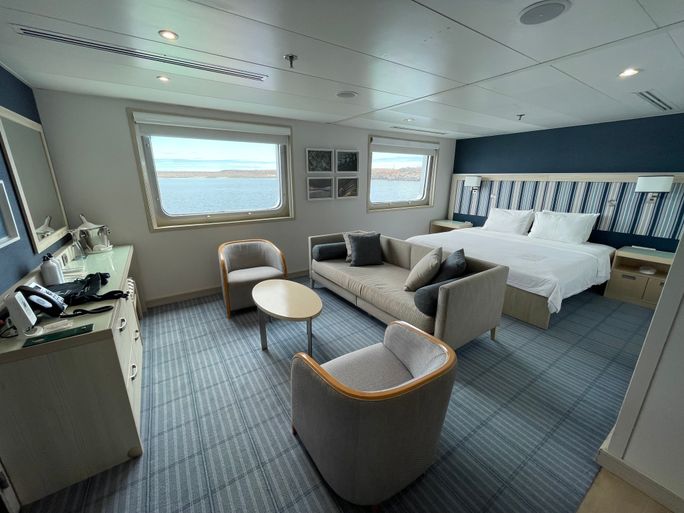
One of the "Darwin's Suites" aboard the MS Santa Cruz II (Photo Credit: Sarah Kuta)
None of the MS Santa Cruz II��s cabins have balconies, but the itinerary is so jam-packed with activities that, even if you��re a balcony devotee like me, you won��t miss having a private outdoor space one bit. On top of that, the ship has several shared outdoor spaces that never feel crowded or cramped. And, because there are so few passengers onboard, the vibe skews social��you��ll probably want to join other guests to relive the day��s adventures anyway.
The ship has several spacious common areas that are perfect for relaxing, learning about the Gal��pagos�� flora and fauna, reading, catching up on emails or simply watching the world pass by outside. All three meals are offered in the Beagle Restaurant, located on the lowest deck.
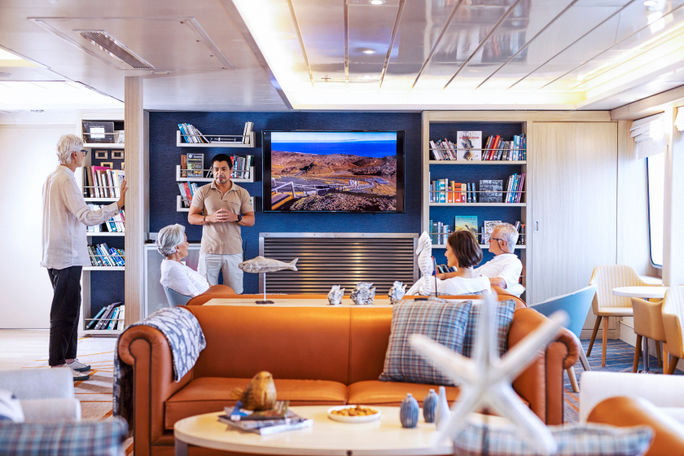
The ship is filled with bright and airy spaces, including the library and Science Center (Photo Credit: HX)
?
Before heading out on excursions, travelers typically congregate in the library (also called the Science Center), a light-filled room at the front of the ship with comfy seating, books, replicas of animal skeletons and bird eggs, microscopes and a coffee and tea station. After returning to the ship in the late afternoon, guests tend to gravitate to the Panorama Bar & Lounge and the adjacent Observation Deck, a massive covered outdoor area at the back of the ship.?
On the top deck, there��s a small but well-equipped gym, as well as a sunny sky deck that doubles as the only spot where smoking is permitted. (During my sailing, I never saw or smelled anyone smoking.) Two small hot tubs are perched at the back of the ship, along with two pairs of washers and dryers that guests can use anytime for free.
Three water stations for refilling the provided reusable water bottles are scattered throughout the ship. The MS Santa Cruz II doesn��t have a pool but, again, you��d be hard-pressed to find time to swim or sunbathe (and there are plenty of opportunities to swim while snorkeling). A small Discovery Room on the expedition deck has sofas and chairs, plus a TV, board games and books.
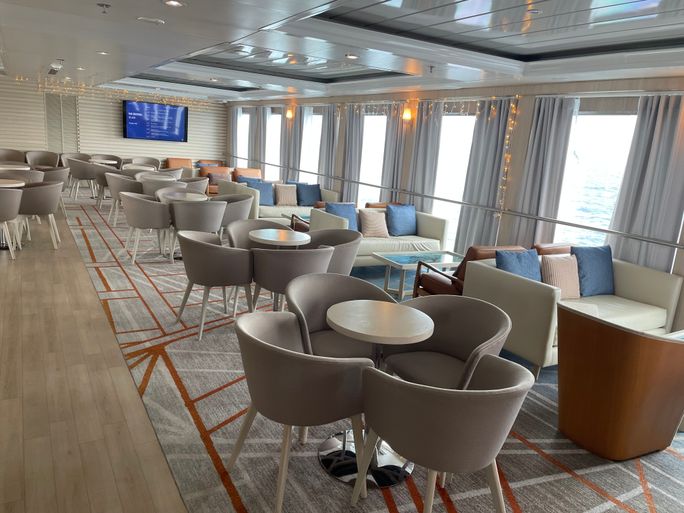
The Panorama Bar & Lounge was a popular spot to hang out aboard the MS Santa Cruz II (Photo Credit: Sarah Kuta)
The ship has Starlink satellite internet, which I found to be strong and reliable throughout the cruise��plenty good enough to answer emails and surf the web. HX warns that the connection can be spotty due to the remote nature of the archipelago, and that it��s not strong enough for more intensive uses, such as downloading files and streaming.
The HX Expedition Cruise Experience
This is a true expedition cruise, meaning the ship visits undeveloped destinations with little to no infrastructure. You can��t just walk off the ship and head into town like you would on a traditional ocean cruise��all stops require a short ride from the ship to land on a panga boat. Similarly, there isn��t a long list of tours and shore excursions to choose from at every stop. And, because of the strict rules within Gal��pagos National Park, you can��t just wander around on your own�� in most places, you must be accompanied by a guide at all times. ?
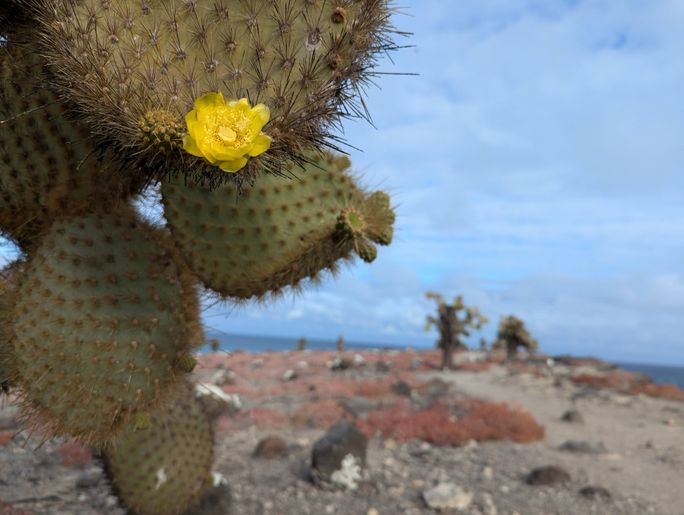
Prickly pear cacti pads are the preferred food of the land iguana (Photo Credit: Sarah Kuta)
So, what does the day-to-day experience look like, then? Most days involve a guided walk led by one of the onboard naturalist guides, plus another outing to go deep-water snorkeling, kayaking or scenic sailing in a glass-bottom boat. (There are standup paddleboards on the ship, but during my cruise, the expedition team never brought them out.)
A handful of stops feature organized activities that most guests choose to participate in, like a tour of the Cerro Colorado Tortoise Reserve on San Crist��bal Island and a visit to the Charles Darwin Research Station on Santa Cruz Island.?
Each day��usually before dinner��the expedition leader holds a briefing to explain the next day��s activities. These are often accompanied by a ��tiny talk,�� or a short lecture given by one of the onboard naturalists about a relevant topic��like the subtle differences between Darwin��s finches or the human history of the archipelago.?
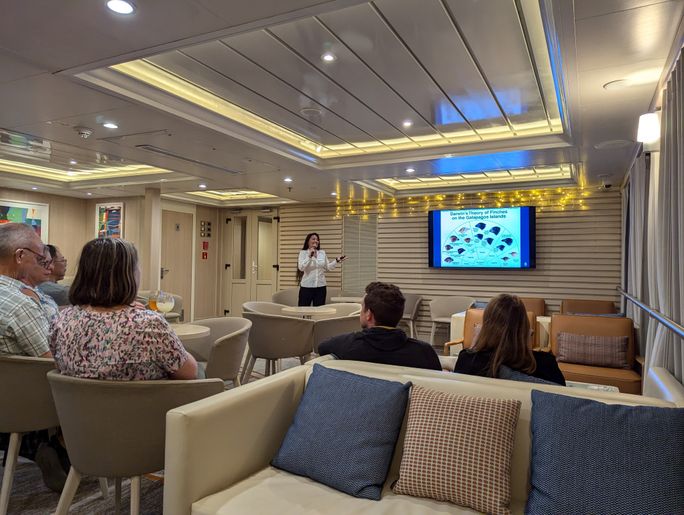
Onboard naturalist guides give "tiny talk" lectures each evening in the Panorama Bar & Lounge (Photo Credit: Sarah Kuta)
Charismatic Wildlife at Every Turn
The Gal��pagos�� highly adapted plants and animals are the main attractions at every landing.?
Some creatures inhabit several islands, like blue-footed boobies and Gal��pagos sea lions, so you��ll have multiple opportunities to see and photograph them. But others are only visible once during the entire journey, like the red-footed boobies at Punta Pitt on San Crist��bal Island and the waved albatrosses on Espa?ola Island. So, if you��re on this trip to see as many species as possible, you��re going to want to join all of the landings��even if you��d rather be taking a nap.
The itinerary is designed to give guests the best chances of spotting wildlife in the?Gal��pagos, and the onboard naturalist guides do a great job of explaining each creature's unique attributes and behaviors. I walked away from the trip with a new appreciation for and deeper understanding of these special animals.
Activities often start early in the morning and continue right up until sunset��it��s a busy, active trip with very little built-in downtime. As our expedition leader, Ramiro, told us during our first briefing: ��You��re going to need a vacation from your vacation.�� That said, guests are welcome to pick and choose their outings, and staying on the ship is always an option.?
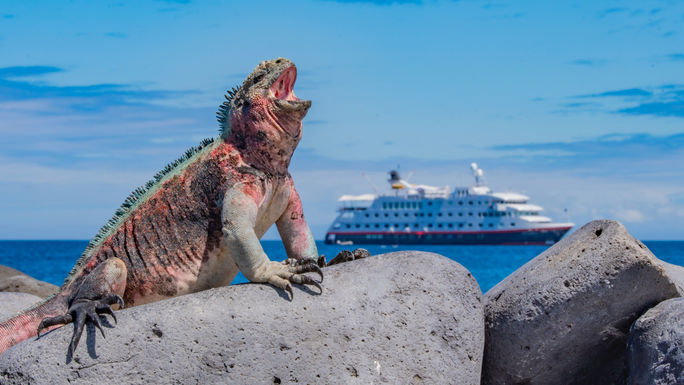
Marine iguanas evolved to swim and feed in the ocean (Photo Credit: HX)
One day, for example, we departed the ship at 8 a.m. for an exploratory panga boat ride around Eden Islet. While a naturalist guide shared facts and information, we slowly cruised along the shoreline, admiring blue-footed boobies, brown pelicans, sea lions, sea turtles, marine iguanas, Sally lightfoot crabs, lava herons and shearwaters.
We returned to the ship for a quick outfit change, then headed right back out to kayak along the coast. During lunch, the ship repositioned to nearby North Seymour Island. We donned our wetsuits for a deep-water snorkeling excursion, where we spotted eagle rays, blacktip reef sharks, iridescent parrotfish and slender trumpetfish.?
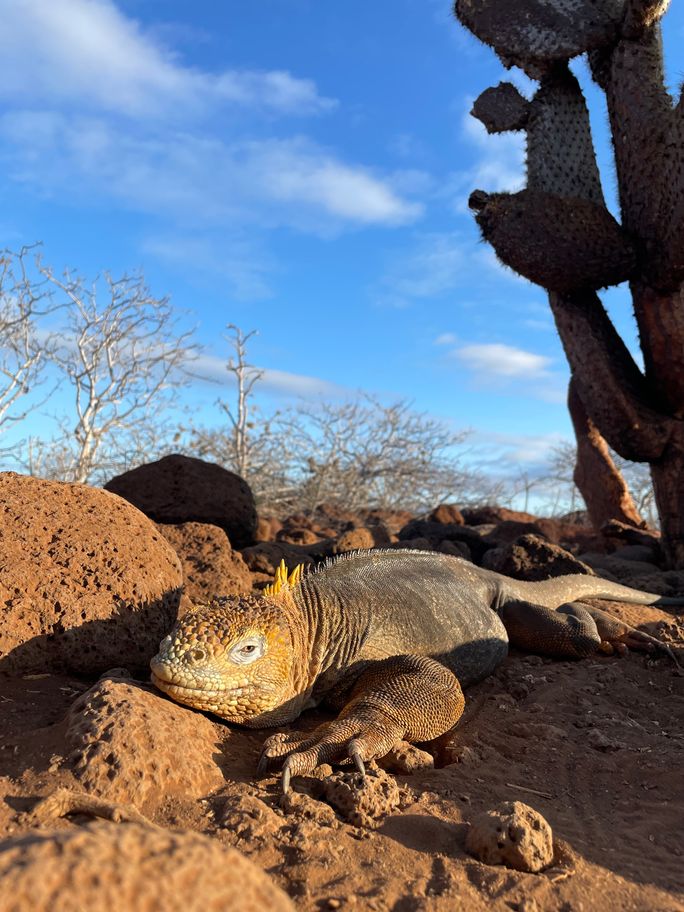
Land iguanas were abundant throughout the archipelago (Photo Credit: Sarah Kuta)
After returning to the ship to change into dry clothes, we headed back out for a hike on North Seymour Island to see two species of frigatebirds��great and magnificent��as well as sea lions, land iguanas, pelicans, scorpions and more blue-footed boobies. Finally, we freshened up for happy hour and dinner.?And that was just one day. ?
Accessibility, Safety and Environmental Protection
The expedition team does a good job of catering to guests of all mobility and fitness levels��so, if, for example, you don��t feel comfortable snorkeling, you can see many of the same aquatic creatures from the glass-bottom boat.
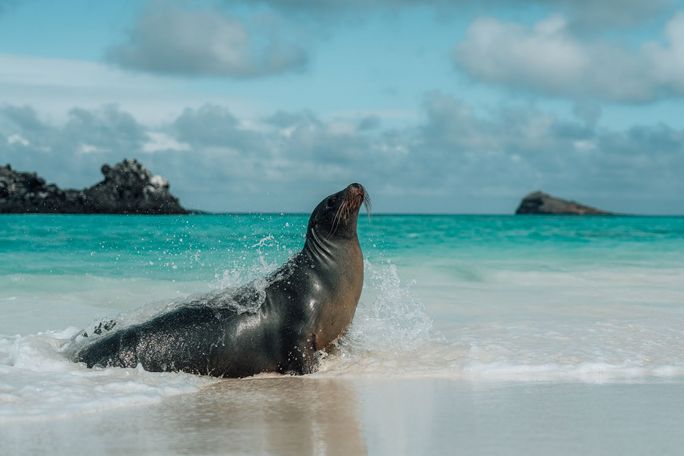
Gal��pagos sea lions are adorable marine mammals that live in the Gal��pagos Islands (Photo Credit: Andres Mesias/HX)
They also thoroughly explain the terrain and exertion required for each activity (including showing pictures and videos), so guests can make informed decisions about whether the day��s hike is too steep or rocky for comfort, or whether to join the ��Rambo�� or ��Mickey Mouse�� snorkeling group.
Safety and adherence to the national park��s rules are paramount. During snorkeling outings, for instance, panga boats are always close by for swimmers to climb into if they get tired��and guides are always watching the water for anyone who needs help.
On land, they also won��t hesitate to call out guests for getting too close to the animals or stepping off the marked trails. It's clear that HX is committed to preserving this pristine environment as much as possible.

An adult waved albatross (right) and a molting juvenile (left) perch on the cliff tops of Espa?ola Island (Photo Credit: Sarah Kuta)
Landings aren��t always guaranteed, either. If the surf is too rough, for example, the expedition team might pivot to a guided coastal cruise on the panga boats instead.?
Fueling Up with Locally Sourced Food and Drink
Since HX��s Gal��pagos voyages are so active, fueling up throughout the day is important��and Ramiro, our expedition leader, often encouraged us to eat a big breakfast. (He and the other guides also regularly reminded us to drink water, which was much appreciated.)?
Breakfast and lunch are served buffet-style, with additional options like made-to-order omelets and eggs. At lunch every day, a server presented each table with that evening��s dinner menu. After a few minutes, he returned to take our orders for dinner. That way, when we returned to the restaurant later that evening, our chosen appetizers were ready immediately; this measure also helps cut down on food waste.
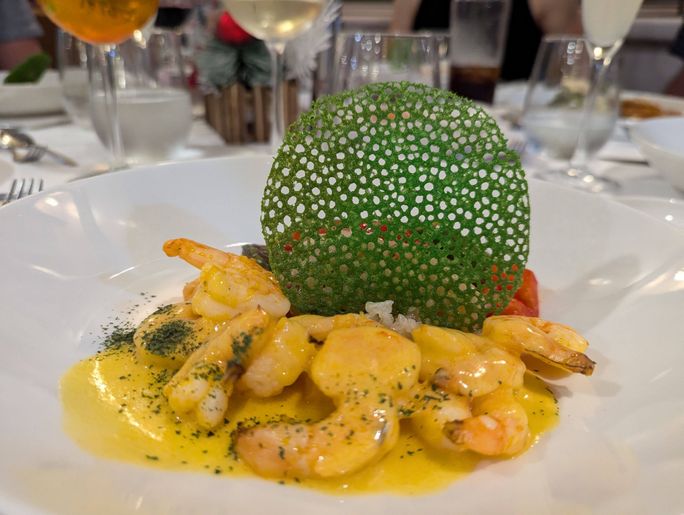
Dinners feature locally sourced foods from the Gal��pagos Islands (Photo Credit: Sarah Kuta)
Dinner is served table-side, but all meals onboard the MS Santa Cruz II are casual affairs��there��s no dress code, and most guests wore comfortable lounge or active wear. All meals are made with locally sourced foods from the Gal��pagos, in accordance with Ecuadorian rules.
After excursions, a selection of sweet and savory snacks were available in the library. And, during happy hour each afternoon, the staff put out a hearty spread in the Panorama Bar & Lounge to tide us over until dinner��bites like empanadas, sushi and mini pork sandwiches. Twice during the trip, happy hour was an outdoor barbecue featuring meat and veggie skewers on the Observation Deck.
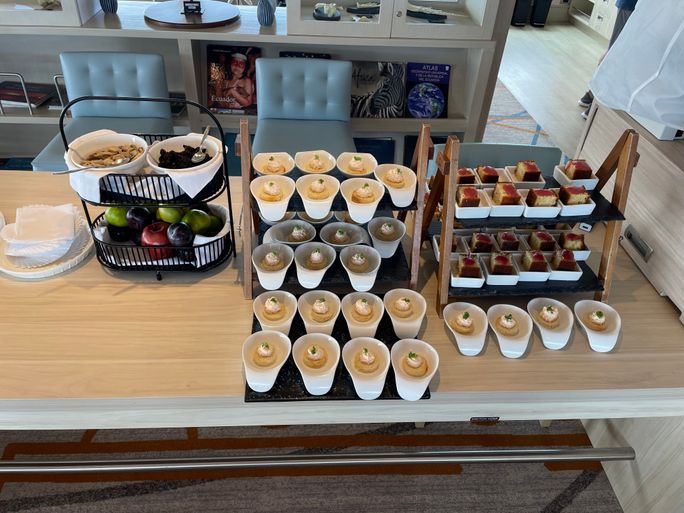
Hearty snacks were available after excursions in the library/Science Center aboard the MS Santa Cruz II (Photo Credit: Sarah Kuta)
Most guests retired to their rooms right after dinner, but a few meandered up to the Panorama Bar & Lounge for a nightcap. The cocktail menu was impressive. In addition to classic drinks, it features locally inspired sips like the Gal��pagos Espresso Martini (made with Gal��pagos coffee, vodka, Earl Grey tea and coffee liqueur) and the Margarita Bucanera (made with horchata, tequila, triple sec and lime).?
Crew members are warm, friendly, knowledgeable and passionate about the destination. They go out of their way to answer questions, accommodate dietary restrictions and preferences, remember drink orders and ensure guests have the best experience possible.?
Don��t Wait to Take Your Bucket-List Trip
This is a once-in-a-lifetime trip that��s ideal for active, adventurous travelers who are curious about plants, animals, geology, history and conservation. I��ve watched my fair share of David Attenborough documentaries, and I am happy to report that the real-life experience of visiting the Gal��pagos not only lived up to the hype but far exceeded my expectations.
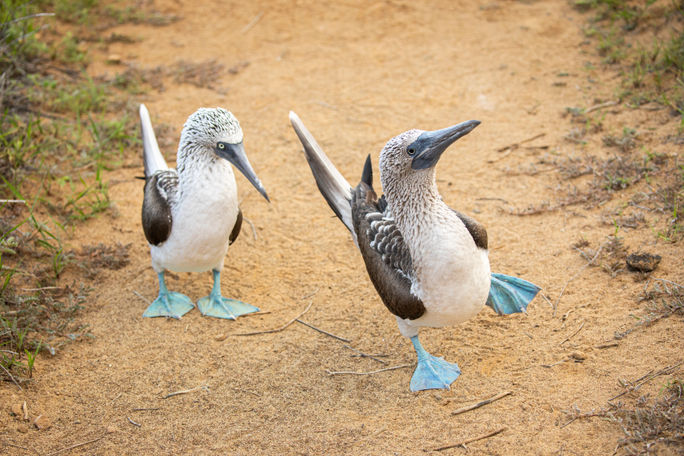
Blue-footed boobies are just one of the iconic species guests can expect to see during an HX expedition cruise in the Gal��pagos Islands (Photo Credit: HX/Ashton Ray Hansen)
The Gal��pagos Islands are well-protected by the Ecuadorian government, as well as several nonprofit conservation groups and other partners. But the archipelago��and the diverse plants and animals that call it home��still faces numerous threats, including climate change, invasive species, pollution, overfishing and habitat loss.
Many travelers wait until retirement to take bucket-list trips like this one. But a Gal��pagos expedition cruise is a highly active trip that requires relatively good mobility��and, if you wait too long, you may not be able to participate fully.
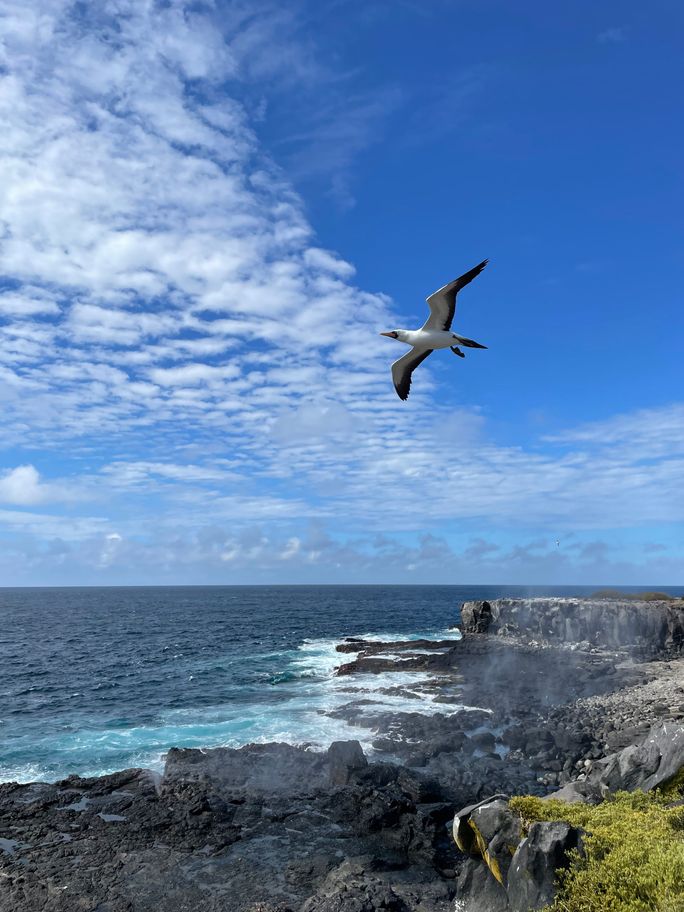
Nazca boobies were nesting on on Espa?ola Island (Photo Credit: Sarah Kuta)
My advice? If you��re at all interested in exploring these unique islands, don��t wait. Plan your trip sooner than later so you can immerse yourself in all that this special place has to offer.
For the latest travel news, updates and deals, subscribe to the daily TravelPulse newsletter.
Topics From This Article to Explore